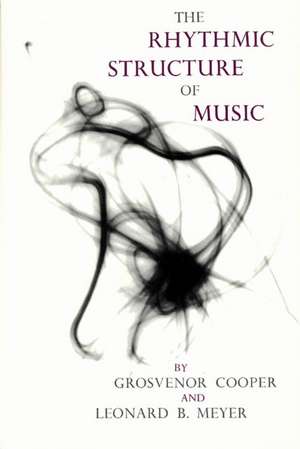The Rhythmic Structure of Music
Autor Grosvenor Cooper, Leonard B. Meyeren Limba Engleză Paperback – 31 mar 1963
In this influential book on the subject of rhythm, the authors develop a theoretical framework based essentially on a Gestalt approach, viewing rhythmic experience in terms of pattern perception or groupings. Musical examples of increasing complexity are used to provide training in the analysis, performance, and writing of rhythm, with exercises for the student's own work.
"This is a path-breaking work, important alike to music students and teachers, but it will make profitable reading for performers, too."—New York Times Book Review
"When at some future time theories of rhythm . . . are . . . as well understood, and as much discussed as theories of harmony and counterpoint . . . they will rest in no small measure on the foundations laid by Cooper and Meyer in this provocative dissertation on the rhythmic structure of music."—Notes
". . . . a significant, courageous and, on the whole, successful attempt to deal with a very controversial and neglected subject. Certainly no one who takes the time to read it will emerge from the experience unchanged or unmoved."—Journal of Music Theory
The late GROSVENOR W. COOPER, author of Learning to Listen, was professor of music at the University of California at Santa Cruz.
"This is a path-breaking work, important alike to music students and teachers, but it will make profitable reading for performers, too."—New York Times Book Review
"When at some future time theories of rhythm . . . are . . . as well understood, and as much discussed as theories of harmony and counterpoint . . . they will rest in no small measure on the foundations laid by Cooper and Meyer in this provocative dissertation on the rhythmic structure of music."—Notes
". . . . a significant, courageous and, on the whole, successful attempt to deal with a very controversial and neglected subject. Certainly no one who takes the time to read it will emerge from the experience unchanged or unmoved."—Journal of Music Theory
The late GROSVENOR W. COOPER, author of Learning to Listen, was professor of music at the University of California at Santa Cruz.
Preț: 256.40 lei
Nou
Puncte Express: 385
Preț estimativ în valută:
49.06€ • 51.35$ • 40.84£
49.06€ • 51.35$ • 40.84£
Carte tipărită la comandă
Livrare economică 31 martie-14 aprilie
Preluare comenzi: 021 569.72.76
Specificații
ISBN-13: 9780226115221
ISBN-10: 0226115224
Pagini: 221
Dimensiuni: 152 x 229 x 15 mm
Greutate: 0.3 kg
Editura: University of Chicago Press
Colecția University of Chicago Press
ISBN-10: 0226115224
Pagini: 221
Dimensiuni: 152 x 229 x 15 mm
Greutate: 0.3 kg
Editura: University of Chicago Press
Colecția University of Chicago Press
Cuprins
I. Definitions and Principles
Architectonic Levels
Pulse
Meter
Rhythm
Accent
Stress
Grouping
II. Rhythms on Lower Architectonic Levels
Trochee and Iamb in Duple Meter
Articulation and Structure
Amphibrach, Anapest, and Dactyl in Duple Meter
Dactyl, Anapest, and Amphibrach in Triple Meter
The Character of Particular Rhythms
Iamb and Trochee in Triple Meter
Rhythmic Ambiguity
The Influence of Rhythm on Melodic Motion
Recapitulation and Illustration
Exercises
III. More Complex Rhythmic Structures
Theoretical Considerations
The Coherence of Higher-Level Rhythms
Groupings on Higher Levels
Analysis of a Whole Section
Exercises
IV. Rhythm and Meter
Meter and the Bar Line
Non-congruence
The Influence of Stress upon Meter
Syncopations, Suspensions, and Ties
Metric Crossing
Exercises
V. Rhythm, Mobility, and Tension
Rhythm and Mobility
Rhythm and Tension
An Extended Anacrusis
An Accented Rest
Summary Example
Exercises
VI. Rhythm, Continuity, and Form
Rhythm, Form, and Morphological Lengths
Continuity and Form
Themes, Non-themes, and Continuity
Rhythm and Texture
Exercises
VII. Rhythmic Development
Ambiguous Rhythm
Rhythmic Vagueness
Rhythmic Transformation
Anacrustic Development
Exercises
VIII. Extended Examples
Chopin, Prelude in E-Flat, Op. 24
Beethoven, Symphony No. 8, First Movement
List of Symbols
Index
Index of Music
Architectonic Levels
Pulse
Meter
Rhythm
Accent
Stress
Grouping
II. Rhythms on Lower Architectonic Levels
Trochee and Iamb in Duple Meter
Articulation and Structure
Amphibrach, Anapest, and Dactyl in Duple Meter
Dactyl, Anapest, and Amphibrach in Triple Meter
The Character of Particular Rhythms
Iamb and Trochee in Triple Meter
Rhythmic Ambiguity
The Influence of Rhythm on Melodic Motion
Recapitulation and Illustration
Exercises
III. More Complex Rhythmic Structures
Theoretical Considerations
The Coherence of Higher-Level Rhythms
Groupings on Higher Levels
Analysis of a Whole Section
Exercises
IV. Rhythm and Meter
Meter and the Bar Line
Non-congruence
The Influence of Stress upon Meter
Syncopations, Suspensions, and Ties
Metric Crossing
Exercises
V. Rhythm, Mobility, and Tension
Rhythm and Mobility
Rhythm and Tension
An Extended Anacrusis
An Accented Rest
Summary Example
Exercises
VI. Rhythm, Continuity, and Form
Rhythm, Form, and Morphological Lengths
Continuity and Form
Themes, Non-themes, and Continuity
Rhythm and Texture
Exercises
VII. Rhythmic Development
Ambiguous Rhythm
Rhythmic Vagueness
Rhythmic Transformation
Anacrustic Development
Exercises
VIII. Extended Examples
Chopin, Prelude in E-Flat, Op. 24
Beethoven, Symphony No. 8, First Movement
List of Symbols
Index
Index of Music







